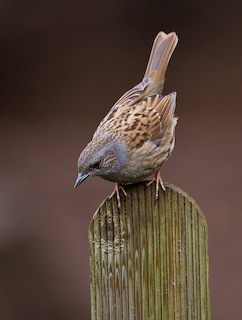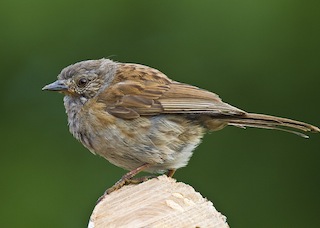 The Dunnock is an unassuming small brown bird, easily confused with but unrelated to the Sparrow. Watch out for it sidling about in the undergrowth.
The Dunnock is an unassuming small brown bird, easily confused with but unrelated to the Sparrow. Watch out for it sidling about in the undergrowth.
Photo: © Natural England/Allan Drewitt
Scientific name: Prunella modularis
Other common names: Hedge Accentor, Hedge Sparrow
Cornish name: Golvan ke
Conservation status: UK Birds of Conservation Concern, Amber; UK Biodiversity Action Plan, Priority Species; IUCN Red List, Least Concern.
What to look for:
- Colouring and appearance: Brown back and neck, streaked with black, very similar to a Sparrow. Grey head with brown crown and patch round eyes. Reddish brown legs. Male and female very similar.
- Size: 14 cm length, 20 cm wingspan.
- Where: Vegetated areas, including woodland, fields with hedges, and gardens. Global range covers Europe and Asia.
- Call: Shrill ‘tseep’, or warbling song. http://www.xeno-canto.org/27116
- Similar species: Sparrow
 This is one of those archetypal ‘small brown birds’ that can be hard for the more inexperienced birder to identify in the field. Indeed, the Dunnock’s common name means “little brown one”, and is an ancient name, deriving from the language of the Celtic Britons. The Dunnock is easy to confuse with the Sparrow, based on appearance alone. Its behaviour gives it away, however. Although found in similar habitats, Dunnocks are far less garrulous and more shy in comparison with noisy, perky Sparrows. A Sparrow’s dashing flights to and from shrubs contrasts with the Dunnock’s habit of sidling through the cover of vegetation as quietly as possible. It keeps close to the ground while flicking its tail and wings as it searches for its invertebrate food (or berries and seeds in the colder months).
This is one of those archetypal ‘small brown birds’ that can be hard for the more inexperienced birder to identify in the field. Indeed, the Dunnock’s common name means “little brown one”, and is an ancient name, deriving from the language of the Celtic Britons. The Dunnock is easy to confuse with the Sparrow, based on appearance alone. Its behaviour gives it away, however. Although found in similar habitats, Dunnocks are far less garrulous and more shy in comparison with noisy, perky Sparrows. A Sparrow’s dashing flights to and from shrubs contrasts with the Dunnock’s habit of sidling through the cover of vegetation as quietly as possible. It keeps close to the ground while flicking its tail and wings as it searches for its invertebrate food (or berries and seeds in the colder months).
Dunnocks are not anything like so unassuming in their sex lives. Females and males each hold their own but overlapping territories. Depending on territory size and food availability, females may have more than one mate, or males may mate with more than one female, and the young in a single brood might easily have different fathers. Males are competitive in terms of monopolising females, and before copulation can be spotted pecking at the female’s cloaca (the opening at the rear end related to the urinary, reproductive and digestive tracts) in order to promote ejection of any other male’s sperm. Some male territories are defended by two birds – an alpha and beta male – which share defence against intruders, although the alpha male also defends his female(s) against copulating with the beta. The female, however, might prefer to mate additionally with the beta, which will then invest more time in caring for the young. It’s all very much like a ‘kitchen-sink drama’.
 The cup-shaped nest, made from twigs and moss and lined with feathers or other soft materials) is built low to the ground in a shrub. The female lays a clutch of up to five blue eggs. As you might expect from their complicated sex lives, the raising of the chicks is also somewhat variable, with alternatives including young being cared for by a single female, or several females with the help of one or of many males.
The cup-shaped nest, made from twigs and moss and lined with feathers or other soft materials) is built low to the ground in a shrub. The female lays a clutch of up to five blue eggs. As you might expect from their complicated sex lives, the raising of the chicks is also somewhat variable, with alternatives including young being cared for by a single female, or several females with the help of one or of many males.
Dunnock nests are a favourite of Cuckoos, especially in the south of the UK. Unlike its other host species, the Cuckoo egg does not match the Dunnock’s own eggs. Even so, Dunnocks seldom recognise and eject it, suggesting that they are a relatively recent host and have not yet evolved a response to the parasitism.
The reason for its Amber listing in the UK is a decline in the breeding population, the reasons for which are unclear, but may relate to changes in woodland management and increased browsing pressure on the shrubs and vegetation used by Dunnocks for hunting and breeding.
Did you know…?
…Dunnocks copulate in less than a second, and can mate up to 100 times per day.
…Of the five Accentor species found in Europe, the Dunnock is the only one found in lowland areas. The others – the Alpine, Siberian, Radde’s and Black-throated Accentors – are all mountain birds.
More information and references:
Svensson, L., Mullarney, K., Zetterstrom, D.,1986. Collins Bird Guide, second edition (translated by Christie, D., Svensson, L.). HarperCollins, London.
Published: October 2014
Author: Amanda Scott
Photos: © Natural England/Allan Drewitt (upper); lower photograph of juvenile, Wikimedia Commons
